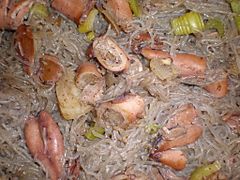Pancit choca facts for kids
 |
|
| Alternative names | pancit choca en su tinta, pancit de choca, pancit choco, pancit pusit, pancit negra, pancit itim, fideos negros, pancit bihon à la negra |
|---|---|
| Course | Main dish |
| Place of origin | Philippines |
| Region or state | Cavite |
| Serving temperature | Hot |
| Main ingredients | squid ink, calamari, rice vermicelli, kamias |
| Similar dishes | paella negra, pancit bihon |
Pancit choca is a special Filipino noodle dish. It's black because it's made with squid ink! This yummy seafood dish also uses bihon, which are thin rice vermicelli noodles. It comes from Cavite, Philippines. People also call it pancit pusit. It's a type of pancit, which means "noodles" in the Philippines.
Contents
What's in a Name?
This dish has a few different names! In Caviteño Chavacano, it's called pancit choca en su tinta. This means "noodle with squid in its own ink." Choca or choco means "squid" in that language.
You might also hear it called pancit pusit. Pusit is the Filipino word for "squid." Other names include pancit itim or pancit negra. Both itim and negra mean "black," which describes the dish's unique color.
How It's Made
Pancit choca is cooked in a way that's a bit like adobong pusit. Here's how it generally works:
Preparing the Squid
First, the squid needs to be prepared. The ink sacs, called lumot, are carefully taken out. It's important not to break them! These sacs hold the special black ink. The rest of the squid is cleaned and cut into rings.
Cooking the Dish
Next, the squid rings are lightly cooked in a pan. Garlic, onion, and bay leaves are added. Sometimes, spicy labuyo chili is also included.
Then, vinegar, soy sauce, a little water, and the saved squid ink are added. This mixture is brought to a boil. Other flavors like patis (fish sauce) and salt can be added too.
Finally, the bihon (rice vermicelli) noodles are put in. The heat is lowered, and the noodles cook until they are soft but still a little firm. Some cooks soften the noodles in hot water first, then mix them in at the very end.
Serving and Toppings
Pancit choca is usually served with tasty toppings. These include crunchy crushed chicharon (pork cracklings). Fresh scallions and kinchay (Chinese celery) are also common.
A special sour fruit called kamias (bilimbi) is sliced thinly on top. To add more flavor, people squeeze calamansi (a small citrus fruit) over the noodles. If you like it spicy, you can add more labuyo chili. Sometimes, dayap (key lime) or biasong (another citrus fruit) are used instead of calamansi.
Different Versions
While bihon noodles are traditional, some versions of pancit choca use sotanghon (glass noodles) instead. You might also find versions that include other seafood like mussels or shrimp. Some cooks even use shrimp stock instead of water for an extra seafood flavor!

